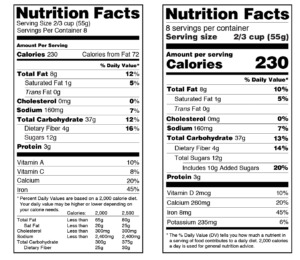For the first time in 20 years, the U.S. Food and Drug Administration (FDA) updated the infamous Nutrition Facts label that’s located on food and drinks. These recent changes are based on years of public input, scientific information, and nutrition research. The following label changes are user friendly, easier to comprehend, and helpful when finding foods that contribute to a healthier lifestyle. Pictured below, the old label is on the left, and the new label is on the right.

1. BOLD AND RELATABLE SERVING SIZES
Indeed, the new label is featuring a bigger and bolder serving size. Serving sizes have also been updated to be more realistic, reflecting typical consumption of the public. However, some foods might still contain more than one serving.
2. CALORIES ARE PROMINENT
Like serving sizes, the calorie section will be bigger and bolder, too. The amount and nutrition advice will still be based on the 2,000 calories a day guideline. Caloric needs are typically based on age, sex, height, weight, physical activity level. Talk to your healthcare provider to for information regarding appropriate caloric intake.
3. NUTRIENT ALTERATIONS
Because research has shown that type of fat is more important than the amount, the “calories from fat” section has been removed. Vitamins A and C have also been removed from the label, as deficiencies for each are rare. Instead, vitamin D and potassium are now required to be on the label, as many Americans do not meet the daily recommendation. For the same reason, iron and calcium values will remain on the label as well.
Consuming too much added sugar hinders meeting nutrient needs and staying within calorie limitations, so “added sugars” have been added to the label. These added sugars include the sugars that are added while the food is being processed, packaged sweeteners, sugars from syrups and honey, and sugar from fruits and vegetable juices.
4. UPDATED DAILY VALUES
The purpose of Percent Daily Value (%DV) is to show the how much of a particular nutrient is in a serving of food. With the update, %DV can be determined by either being “low” or “high.” According to the FDA, “5% DV or less of a nutrient per serving is considered low and 20% DV or more of a nutrient per serving is considered high.” There’s an added footnote stationed at the bottom of the nutrition label for better comprehension of %DV, too.
THE FDA WANTS THE LABEL TO WORK FOR YOU.
Use the label to support healthy dietary needs, like opting for choices that are higher in fiber, vitamin D, calcium, potassium, and iron. Avoid foods that are high in saturated fat, sodium, and added sugars. With this new label, you can reduce the risk of developing obesity, diabetes, high blood pressure, and cardiovascular disease.
Source: The United States Food and Drug Administration site. The New Nutrition Facts Label. Updated June 29, 2020. https://www. fda.gov/food/nutrition-education-resources-materials/new-nutrition-facts-label. Accessed July 30, 2020.





